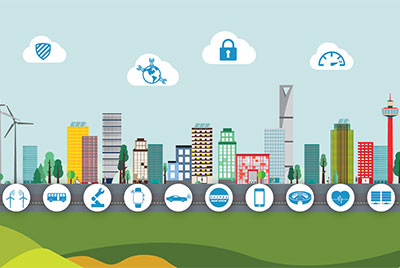Last updated 10 November 2023
Do you want to know more about 5G technology? Then you're in the right place.
On this Q&A page, you'll discover key facts about 5G:
- What is 5G? and what is 5G+?
- How fast is 5G?
- What is the difference between 4G and 5G?
- What are the 5G use cases?
- When is 5G coming, and where is it available?
- What does it mean for consumers and operators?
- What's the relation between 5G and satellites?
- Will 5G technology be secure?
Let's see how 5G technology is changing the world.

What is 5G?
5G technology is a breakthrough.
The next generation of telecom networks (fifth generation or 5G) started hitting the market at the end of 2018 and will continue to expand worldwide.
Beyond speed improvement, the technology is expected to unleash a massive 5G IoT (Internet of Things) ecosystem where networks can serve communication needs for billions of connected devices, with the right trade-offs between speed, latency, and cost.
This makes sense if you think about what 5G has to offer.
5G technology is driven by 8 specification requirements:
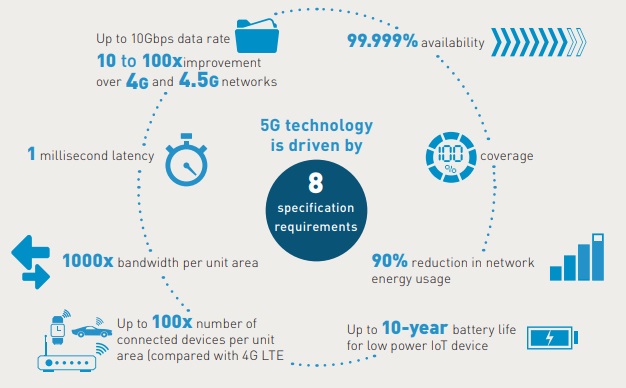
- Up to 10Gbps data rate - > 10 to 100x speed improvement over 4G and 4.5G networks
- 1-millisecond latency
- 1000x bandwidth per unit area
- Up to 100x number of connected devices per unit area (compared with 4G LTE)
- 99.999% availability
- 100% coverage
- 90% reduction in network energy usage
- Up to 10-year battery life for low-power IoT device
How fast is 5G?
5G speed tops out at 10 gigabits per second (Gbps).

What makes 5G faster? Good question!
According to communication principles, the shorter the frequency, the larger the bandwidth.
Using shorter frequencies (millimeter waves between 30GHz and 300GHz) for 5G networks is why 5G can be faster. This high-band 5G spectrum provides the expected boost in speed and capacity, low latency, and quality.
According to the February 2020 issue of Fortune Magazine, average 5G speed measures done in Q3/Q4 2019 range from:
- 220 megabits per second (Mbps) in Las Vegas,
- 350 in New York,
- 380 in Los Angeles,
- 450 in Dallas,
- to 550 Chicago,
- and over 950 in Minneapolis and Providence, approximately.
Some download and upload 5G speed tests in Australia, America, and China
In conclusion, 5G speeds are not uniform; they can significantly fluctuate based on factors such as distance from the cell tower, environmental obstacles, and network traffic.
But here is the part where you understand the benefits of 5G go beyond speed.
What is 5G low latency?
Just think about it.
A millisecond is 1/1000 of a second.
The average reaction time for humans to a visual stimulus is 250 ms or 1/4 of a second. People are capped at around 190-200 ms with proper training.
Imagine now that your car could react 250 times faster than you.
Imagine it could also respond to hundreds of incoming information and communicate its reactions to other vehicles and road signals within milliseconds.
At 60 mph (100km/h), the reaction distance is about 33 yards (30 meters) before you pull on the brakes. With a 1ms reaction time, the car would only have rolled more than one inch (less than 3 centimeters).

Use cases associated with low latency are:
- V2X (Vehicle-to-Everything) communication: V2V: (Vehicle-to-Vehicle), V2I (Vehicle-to-Infrastructure), autonomous, connected cars
- Immersive Virtual Reality Gaming (5G will bring VR to the masses.)
- Remote surgical operations (aka telesurgery)
- Simultaneous translating.
In other words, 5G and IoT create the perfect match.
So, let's see what makes 5G so different from 4G.
5G vs 4G - What is the difference?
The 5th generation of wireless networks addresses the evolution beyond mobile internet to massive IoT (Internet of Things) from 2019/2020.
- For example, low latency provides real-time interactivity for services using the cloud, which is key to the success of self-driving cars.
- 5G vs 4G also means at least x100 devices connected. 5G must support 1 million devices for 0.386 square miles or 1 km2.
- Also, low power consumption is what will allow connected objects to operate for months or years without the need for human assistance.
Unlike current IoT services that make performance trade-offs to get the best from current wireless technologies (3G, 4G, Wi-Fi, Bluetooth, Zigbee, etc.), 5G networks will be designed to bring the level of performance needed for massive IoT.
It will enable a perceived entirely ubiquitous connected world.
In short, that's what makes it transformational.
5G and the previous mobile generations at a glance
In the last four decades, mobile phones, more than any other technology, have quietly changed our lives forever.
Do you remember how much you loved your 2G Nokia 3310?
- 1G, the first generation of telecom networks (1979), let us talk to each other and be mobile
- 2G digital networks (1991) let us send messages and travel (with roaming services)
- 3G (1998) brought a better mobile internet experience (with limited success)
- 3.5G brought a truly mobile internet experience, unleashing the mobile app ecosystem
- 4G (2008) networks brought all-IP services (Voice and Data), a fast broadband internet experience, with unified network architectures and protocols
- 4G LTE ( for Long Term Evolution), starting in 2009, doubled data speeds. While LTE boasts extensive network coverage, 5G is still in the initial phases of being rolled out.
- 5G networks (2019) expand broadband wireless services beyond mobile internet to IoT and critical communications segments
Virtual networks (5G slicing) tailored to each use case.
5G will support all communication needs from low-power Local Area Networks (LAN) – like home networks, such as Wide Area Networks (WAN), with the proper latency/speed settings.
This need is addressed today by aggregating various communication networks (Wi-Fi, Z-Wave, LoRa, 3G, 4G, etc.)
And 5G is more innovative.
5G is designed to allow simple virtual network configurations to align network costs with application needs better.
This new approach will allow 5G Mobile Network operators to catch a larger IoT market by delivering cost-effective solutions for low-band, low-power applications.
Some recent illustrations:
- Hewlett-Packard builds a private network for the 2023 Ryder Cup (September 2023).
- NTT and Las Vegas launch the largest private 5G network in the US (September 2022)
- Porsche and Vodafone build a hybrid private network (December 2022)
What is 5G+?
5G+ is a step up from standard 5G, designed to boost network speed, capacity, and coverage by as much as 50%.
Imagine at busy events, like concerts or games, 5G+ cuts through digital crowd jams, letting you download an HD movie in a minute.
While standard 5G utilizes low-band spectrum to extend coverage and enhance reliability, it delivers speeds only marginally faster than 4G LTE.
On the other hand, 5G plus leverages millimeter wave technology to achieve breakneck speeds, though with a shorter range.
What are the real 5G use cases?
Each new generation wireless network came with a new set of new usages.
The next 5G will make no exception and focus on IoT and critical communications applications.
In terms of the schedule, we can mention the following use cases over time:
- Fixed wireless access (from 2018-2019 onwards)
- Enhanced mobile broadband with 4G fallback (from 2019-2020-2021)
- Massive M2M / IoT (from 2021-2022)
- Ultra low-latency IoT critical communications (from 2024-2025)
Some critical applications, like self-driving cars, require very aggressive latency (fast response time), while they do not require quick data rates.
Conversely, enterprise cloud-based services with massive data analysis will require speed improvements more than latency improvements.
When is 5G coming?
5G availability and speed in 2023
5G rollout: Where do we stand?
Over four years since its launch, 5G technology has significantly matured, achieving broader and faster coverage.
As of June 2023, 5G has reached 1.1 billion subscriptions globally, with an addition of 125 million in the first quarter alone. About 240 service providers have established 5G networks, and 35 have launched 5G Standalone (SA) networks.
As of early 2023, users have over 700 5G smartphone models to choose from. GSMA Intelligence predicts rapid 5G expansion, with connections set to reach 2 billion by 2025, outpacing 3G and 4G rollouts.
By 2028, 5G is expected to encompass 4.6 billion subscriptions, overtaking half of all mobile subscriptions.
5G availability
Regarding availability, South Korea and Puerto Rico are leading, with nearly half of their 5G users spending most of their time connected to 5G, according to OPENSIGNAL benchmarks of June 2023.
The US follows closely with a 31.1% availability rate. However, availability varies in Europe, with Finland and Bulgaria at the top (24.2% - 24.7%) but significant markets like the UK lagging behind (10.1%).
Singapore and Taiwan are at 30% in Asia, with Malaysia at 20.5%.
5G speed in 2023
Speed-wise, 5G is transforming digital experiences with average download speeds many times faster than 4G, with India (19.2x), Malaysia (14.4x), and Brazil (13.5x) witnessing the most significant jumps.
Regarding absolute speeds, South Korea leads at 432.5Mbps, with seven markets exceeding 300Mbps. For gaming and video streaming, 5G provides an enhanced experience, with improvements of up to 37.6% in video and 31.3% in gaming experiences across various markets.
When did 5G come out in the US?
North America 5G was available in some locations in 2019. It took off in most areas in 2020.
More precisely, ATT announced nationwide coverage in the US in the first half of 2020. Verizon 5G was the first carrier to roll out 5G.
5G is being set up much quicker than 4G ever was.
The first 5G network covered the whole country twice as fast as 4G. Also, the top three phone service providers got their 5G networks up and running nationwide 1.5 times quicker than they did with 4G.
Currently, 5G networks in the US reach over 325 million people, making America's 5G the most widespread worldwide. According to Ookla, the US leads globally, with more than half of 5G-ready phones using a 5G network most of the time.
That's almost 20% more than South Korea and nearly twice as much as China, where only about 27.3% have 5G availability.
5G in Germany, France and the UK
Deutsche Telekom started 5G in Berlin, Darmstadt, Munich, Bonn, and Cologne in Sept 2019. In December 2021, major cities (53% of the territory) were covered by 5G services.
In August 2023, Telefonica Germany reached 90% of 5G coverage. The company is targeting nationwide coverage for 2025.
5G networks covered 89% of Germany's territory as of July 2023.
Telcos in France announced 5G offers by 2020 for real availability in 2021. By 2030, France should be covered by 5G.
In the UK, many cities have seen 5G in 2019 and more in 2020. EE, Vodafone, and O2 have been actively deploying 5G since mid-2019.
The UK was quick to start using 5G in 2019, but now it's not keeping up.
Why? According to the Financial Times of 2 August 2023, phone companies haven't been spending enough. Ofcom says that while 82% of homes and workplaces in the UK can get 5G from at least one company, only 22% have it from all the phone services.
5G in India
- India Telcos started their 5G rollouts in October 2022. The number of users now exceeds 100 million, according to the main operators, Bharti Airtel and Reliance Jio, driving the push. It's one-sixth of the 600 million phone users.
- According to the GSMA, median 5G download speeds are 25 faster than 4G in the country.
5G and China
- China Unicom has set up 5G in a few locations in 2019. China Mobile said it had deployed over 560,000 5G base stations as of November 2021.
- In August 2023, China Broadnet announced it had reached nationwide 5G coverage.
- In June 2023, China Mobile said the country will achieve a 90% penetration rate in 2023. The company will have 2 million 5G base stations by the end of this year. China Mobile's 5G end-users exceeded 480 million in June.
Find more resources: 5G availability worldwide as of September 2023, or check the interactive weekly updated Ookla 5G map.
This brings us to our next point.
How fast will 5G take-up be?
The projected adoption rate for 5G differs drastically from all previous generation networks (3G, 4G).
Ericsson reports that as of early 2023, there are now 1.1 billion 5G subscribers worldwide, with an increase of 125 million in the first quarter alone.
About 240 service providers have rolled out 5G networks, and approximately 35 have introduced or set up 5G Standalone (SA) networks. By the end of 2028, the number of 5G users is projected to hit 4.6 billion, representing more than half of all mobile users globally.
- By 2030, 6G will probably start commercial rollouts.

What are the implications of 5G for mobile operators?
5G is still a cellular broadband technology and is a network of networks.
MNOs' expertise and knowledge in building and operating networks will be crucial to the success of 5G.
Beyond providing network services, MNOs will develop and operate new IoT services.
Implementing 5G networks while keeping 3G and 4G networks operational will likely trigger a new challenge for MNOs regarding the ability of frequencies in the spectrum (mainly if the forecasted massive volume of IoT occurs).
MNOs must operate a new spectrum in the 6 to 300 GHz range (typical 5G bandwidth), which means massive network infrastructure investments.
To reach the 1ms latency goal, 5G networks imply connectivity for the base station using optical fibers.
5G networks are planned to support virtual networks such as low power, low throughput (LPLT) networks for low-cost IoT on the cost savings side, unlike today where LORA networks address that need separately from 4G.
What does 5G mean for consumers?
5G for consumers means faster mobile internet, but mainly internet connectivity in many more objects than you see today.
The car and the house are two examples of the big IoT revolution coming ahead, supported by 5G networks.
According to the GSA report (April 2023), there are 1,513 commercially available 5G devices, representing 79.8% of all announced 5G devices.
This is an increase of 51.3% in the number of commercial 5G devices since the end of March 2022.
The number of commercially available devices has been growing steadily since the start of the year and should continue to increase as more devices reach the market.
5G SIM cards made their debut in 2019 and 2020.
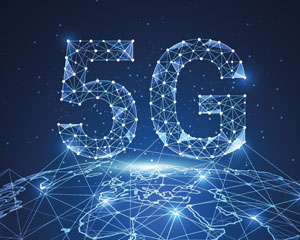
What's the relation between 5G and satellites?
5G satellite communication -directly from the sky to the device- will soon become a reality.
Indeed, a new generation of satellites will bring onboard 5G capabilities to ensure full 5G coverage of the Earth and the terrestrial mobile 5G networks.
Specifically, with space-based systems, 5G will offer higher accessibility, reliability, resilience, and broadcasting and multi-broadcasting capabilities.
We expect 5G to support a wide variety of applications (e.g., agriculture, logistics, public safety) so that everybody in the world can be connected.
Along with space and mobile phone manufacturers, Thales Alenia Space supports the efforts of 3GPP to develop solutions embracing the vision of a single global space-based network fully integrated with mobile operators' 5G networks.
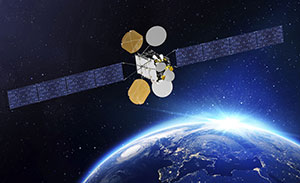
At the beginning of 2021, South Korean operator KT SAT, a subsidiary of the world's first 5G commercial service provider, Korea Telecom, led a 5G satellite demonstration using the geostationary Koreasat 5A telecommunication satellite to provide a 5G network to remote areas. More recently, Hellas Sat performed a successful 5G demonstration in Greece: it backhauled the connection between a 5G Core Network and a 5G gNB through Hellas Sat 3 / Inmarsat S EAN satellite.
Thales Alenia Space manufactured both satellites.
Will 5G technology be secure?
4G networks use the USIM application to perform strong mutual authentication between the user and their connected device and the networks.
The entity hosting the USIM application can be a removable SIM card or an embedded UICC chip.
This strong mutual authentication is crucial to enable trusted services.
Today, security solutions are already a mix of security at the edge (device) and the core (network).
Several security frameworks may co-exist in the future, and 5G is likely to re-use existing solutions used today for 4G networks and the cloud (SEs, HSM, certification, Over-The-Air provisioning, and KMS).
The standard for strong mutual authentication for 5G networks was finalized in 2018.
With the increased impact of IoT services, the need for 5G security, privacy, and trust will be as strong as for 4G, if not stronger.
Local SEs in devices can secure network access and support secure services such as emergency call management and virtual IoT networks.
5G connectivity promises to break traditional data delivery paradigms by providing network connectivity almost everywhere.
New business opportunities drive data-in-motion security requirements to include network transparency, low latency, high-level bandwidth, consistency in delivery, and complete interoperability.
To accommodate this new paradigm in data delivery, the build-out of 5G infrastructures is underway.
Older, more traditional data-in-motion security methods are no longer viable solutions to these diverse 5G requirements.
Additionally, these older technologies cannot meet today's challenges of auditable compliance and the not-so-distant future's quantum threat challenges.
Security, performance, interoperability, and auditable compliance are just some 5G challenges that require immediate attention.
There is a need for a more intelligent data-in-motion security solution to accommodate the diverse range of 5G use cases.
How will 5G impact roaming?
While traveling abroad, 5G users will seamlessly enjoy a 5G roaming experience on visited networks. A fallback to 3G-4G will be guaranteed.
How will 5G boost the commercialization of IoT devices relying on cellular rather than Wi-Fi technology?
Wi-Fi wireless is a "Local Area Network" technology limited in operating range, speed, and latency.
IoT services demand more ubiquity, mobility, performance speed, and response time.
5G will truly unleash a vibrant IoT ecosystem.

How will 5G network use cases change the world?
The "perception" of speed, instantaneous response time, and IoT performance will become a reality thanks to 5G.
It's set to change our world in many ways:
- Healthcare: Imagine having a doctor's appointment over a crystal-clear video call or surgeons operating remotely with robotic precision – 5G makes it possible with its fast and stable connections.
- Smart Cities: City life will become more efficient as 5G helps manage traffic flows, public transport, and energy use, making cities cleaner and less congested.
- Driverless Cars: These vehicles will be able to communicate with each other to avoid accidents and ease traffic, thanks to the quick and reliable data 5G can send.
- Manufacturing: Factories will become more automated and efficient. With 5G, machines can talk to each other instantly, reducing errors and speeding up production.
- Farming: Sensors can tell farmers exactly when crops need water or care, helping save resources and boost harvests.
- Entertainment: Streaming movies without buffering and playing online games with no lag will be the norm, as 5G delivers content much faster than before.
- Education: Students could take virtual field trips or get hands-on with complex subjects through augmented reality, all facilitated by 5 G's speedy connection.
- Emergency Services: Faster communication can help emergency responders coordinate better and save more lives.
- Retail: Shopping experiences will be transformed with virtual fitting rooms and personalized recommendations, thanks to 5 G's ability to handle large amounts of data.
- Energy: Managing power grids will become more efficient, helping to reduce waste and keep our homes powered without interruption.
5G isn't just a new way to connect phones; it's a foundation for a more connected and efficient future.
Now it's your turn.
What do you think?
If you've something to say on 5G technology and networks, testimonials on 5G speed, a question to ask, or have found this article useful, please comment below.
We'd also welcome suggestions on improving it or proposals for future papers.
We look forward to hearing from you.
More resources on 5G technology
Discover below our white paper, survey, e-book, blog posts, and related press releases.
White Papers

eSIM Solutions: accelerating digital transformation for Mobile Network Operators
Read our brochure
Thales DigitalTelco Suite for the subscriber digital journey (Whitepaper)
Providing smooth mobile-based subscription management
Read our whitepaper
A New Trust Model For The 5G Era
5G use cases will bring new requirements on the storage, compute and network domains and will introduce new risks to the confidentiality, integrity and availability of enterprise & user data. This White Paper provides Thales' recommendations to address these new challenges and build a new trust model for the 5G era.
Building a new trust model in the 5G eraSurvey

5G Security
In 2020, Thales has run a survey tackling 5G Security towards mobile industry specialists.
Read the Next Steps for 5G Survey ReportE-book
Q&A
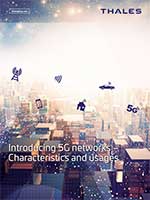
Introducing 5G networks – Characteristics and usages
The fifth generation networks (5G) is currently under development and will hit the market at the horizon 2020. Compared with the current 4G LTE technology, 5G is targeting to reach both high speed (1 Gbps), low power and low latency (1ms or less), for massive IoT, tactile internet and robotics.
Introducing 5G networks – Characteristics and usagesPress Release
BLOG
Our lastest articles about 5G
Training
5G overview & subscriber security essentials for next-generation networks
A comprehensive insight into 5G evolutions for digital transformation
Training agenda